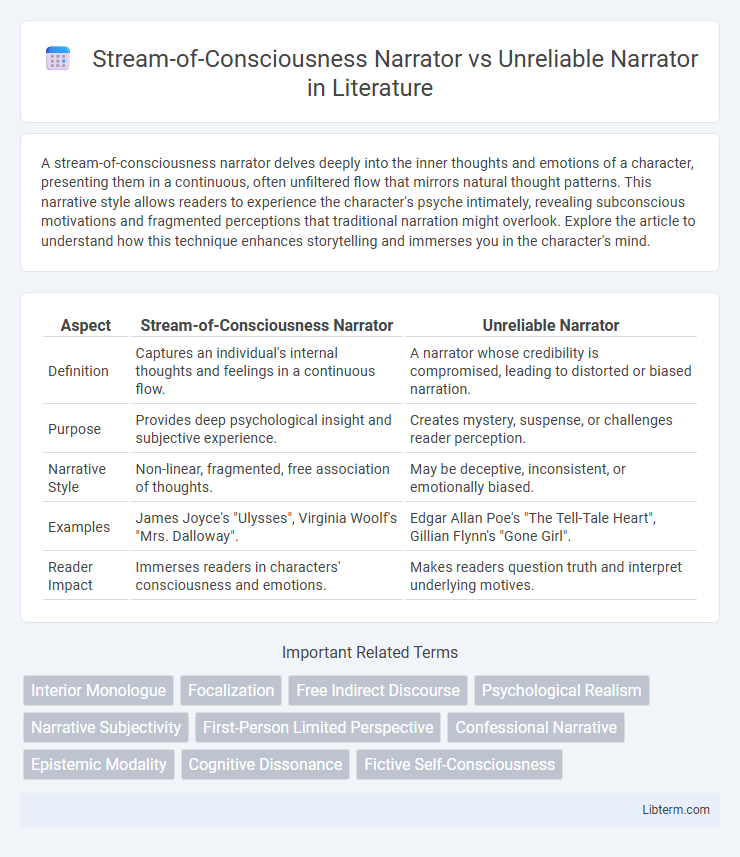A stream-of-consciousness narrator delves deeply into the inner thoughts and emotions of a character, presenting them in a continuous, often unfiltered flow that mirrors natural thought patterns. This narrative style allows readers to experience the character's psyche intimately, revealing subconscious motivations and fragmented perceptions that traditional narration might overlook. Explore the article to understand how this technique enhances storytelling and immerses you in the character's mind.
Table of Comparison
| Aspect | Stream-of-Consciousness Narrator | Unreliable Narrator |
|---|---|---|
| Definition | Captures an individual's internal thoughts and feelings in a continuous flow. | A narrator whose credibility is compromised, leading to distorted or biased narration. |
| Purpose | Provides deep psychological insight and subjective experience. | Creates mystery, suspense, or challenges reader perception. |
| Narrative Style | Non-linear, fragmented, free association of thoughts. | May be deceptive, inconsistent, or emotionally biased. |
| Examples | James Joyce's "Ulysses", Virginia Woolf's "Mrs. Dalloway". | Edgar Allan Poe's "The Tell-Tale Heart", Gillian Flynn's "Gone Girl". |
| Reader Impact | Immerses readers in characters' consciousness and emotions. | Makes readers question truth and interpret underlying motives. |
Defining Stream-of-Consciousness Narrators
Stream-of-consciousness narrators present a continuous flow of a character's thoughts and feelings, capturing their inner experiences in a raw and unfiltered manner. This narrative style emphasizes the subjective and often nonlinear nature of cognition, immersing readers directly into the protagonist's mind. Unlike unreliable narrators, who may distort reality or deceive the audience, stream-of-consciousness narrators reveal authentic mental processes without deliberate misrepresentation.
Understanding Unreliable Narrators
Understanding unreliable narrators involves recognizing their subjective interpretation of events, which may distort reality due to bias, mental instability, or intentional deception. Stream-of-consciousness narration often provides direct access to a character's thoughts, exposing their inner conflicts and contributing to unreliability by presenting fragmented, non-linear perception. Distinguishing these narrative techniques enhances the analysis of complex storytelling and deepens comprehension of character psychology and thematic layers.
Key Differences Between the Two Narrative Techniques
Stream-of-consciousness narrators provide a deep, unfiltered access to a character's continuous flow of thoughts and feelings, capturing inner experiences in real time. Unreliable narrators present a biased or distorted version of events, often misleading readers through intentional deception, memory lapses, or subjective viewpoints. The key difference lies in the purpose: stream-of-consciousness emphasizes psychological depth and immediacy, while unreliable narration questions the truthfulness and accuracy of the narrative itself.
Common Literary Examples of Stream-of-Consciousness Narrators
Stream-of-consciousness narrators, exemplified by characters like Molly Bloom in James Joyce's "Ulysses" and Clarissa Dalloway in Virginia Woolf's "Mrs. Dalloway," provide an intimate, unfiltered flow of thoughts and feelings that mimic natural cognition, enhancing narrative depth and psychological complexity. Unlike unreliable narrators such as Humbert Humbert in Nabokov's "Lolita," whose credibility is compromised by deception or biased perspective, stream-of-consciousness narrators prioritize raw cognition over narrative reliability. This technique is integral to modernist literature, where authors utilize interior monologue to reveal subconscious processes and challenge conventional storytelling structures.
Unreliable Narrators in Classic and Modern Literature
Unreliable narrators in classic and modern literature manipulate readers' perceptions through biased, distorted, or deceptive storytelling, as seen in Edgar Allan Poe's "The Tell-Tale Heart" and Gillian Flynn's "Gone Girl." These narrators often reveal psychological complexity and challenge objective truth, deepening narrative ambiguity and reader engagement. Literary techniques like fragmented narratives, contradictory details, and shifting perspectives highlight unreliability, making such narrators central to exploring themes of identity, memory, and truth.
Narrative Impact: Reader Perception and Engagement
Stream-of-consciousness narrators immerse readers in the character's unfiltered thoughts, fostering deep psychological insight and heightened emotional engagement, but their fragmented style can challenge comprehension and create subjective interpretation. Unreliable narrators manipulate the narrative truth, prompting readers to question the authenticity of the story and actively piece together hidden meanings, which increases suspense and critical engagement. Both techniques significantly influence reader perception by shaping trust and immersion, ultimately altering the narrative's impact through varying levels of clarity and ambiguity.
Purpose and Effect of Each Narration Style
Stream-of-consciousness narration captures the continuous flow of a character's thoughts and feelings, offering an intimate and immersive experience that reveals their psychological depth and emotional state. Unreliable narration deliberately distorts reality from the narrator's perspective, creating suspense and encouraging readers to question the truth and discern underlying motives. Both styles enhance narrative complexity by shaping readers' engagement and interpretation, with stream-of-consciousness emphasizing internal experience and unreliable narration challenging objective reality.
Challenges for Authors: Crafting Authentic Voices
Crafting authentic voices in stream-of-consciousness narration demands capturing a character's raw, unfiltered thoughts while maintaining coherence and reader engagement. Unreliable narrators challenge authors to balance misleading or biased perspectives without alienating readers, requiring careful layering of clues and subtle inconsistencies. Both narrative techniques compel writers to intricately design voice, tone, and psychological depth to enhance story immersion and complexity.
Reader Interpretation: Trust, Doubt, and Ambiguity
Stream-of-consciousness narrators immerse readers in the protagonist's internal thoughts, offering an intimate but unfiltered view that challenges readers to discern reality from subjective perception. Unreliable narrators intentionally distort facts, compelling readers to question the truth and navigate ambiguity through skepticism and critical analysis. Both narrative styles demand active engagement, as readers must balance trust and doubt to interpret meaning amid fragmented or biased perspectives.
Choosing the Right Narrator for Your Story
Selecting the ideal narrator hinges on the story's desired depth and reader engagement; stream-of-consciousness narrators grant intimate access to a character's raw, unfiltered thoughts, creating a vivid psychological landscape. Unreliable narrators, characterized by biased or distorted perceptions, inject suspense and complexity by prompting readers to question the truthfulness of the narrative. Writers must evaluate whether immersive internal experience or narrative ambiguity best amplifies the thematic and emotional impact of their story.
Stream-of-Consciousness Narrator Infographic

 libterm.com
libterm.com